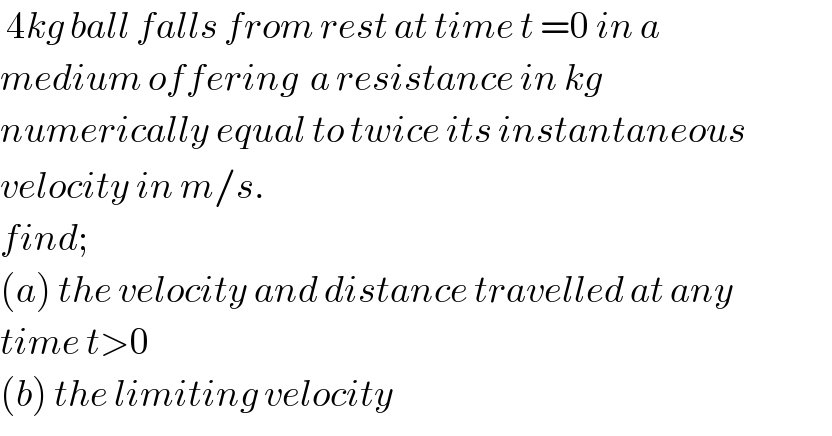Question Number 28375 by Ruchinna1 last updated on 25/Jan/18

$$\:\mathrm{4}{kg}\:{ball}\:{falls}\:{from}\:{rest}\:{at}\:{time}\:{t}\:=\mathrm{0}\:{in}\:{a}\: \\ $$$${medium}\:{offering}\:\:{a}\:{resistance}\:{in}\:{kg}\: \\ $$$${numerically}\:{equal}\:{to}\:{twice}\:{its}\:{instantaneous} \\ $$$${velocity}\:{in}\:{m}/{s}. \\ $$$${find}; \\ $$$$\left({a}\right)\:{the}\:{velocity}\:{and}\:{distance}\:{travelled}\:{at}\:{any}\: \\ $$$${time}\:{t}>\mathrm{0}\: \\ $$$$\left({b}\right)\:{the}\:{limiting}\:{velocity}\: \\ $$
Answered by mrW2 last updated on 25/Jan/18
![R=2v [kg]=2gv [N] mg−R=ma=m(dv/dt) mg−2gv=m(dv/dt) 4g−2gv=4(dv/dt) ⇒5(2−v)=(dv/dt) ⇒(dv/(2−v))=5dt ⇒∫_0 ^( v) (dv/(2−v))=5∫_0 ^( t) dt ⇒[−ln (2−v)]_0 ^v =5[t]_0 ^t −ln ((2−v)/2)=5t 1−(v/2)=e^(−5t) ⇒v=2(1−e^(−5t) ) ⇒(ds/dt)=2(1−e^(−5t) ) ⇒s=2∫_0 ^( t) (1−e^(−5t) )dt=2(t+((e^(−5t) −1)/5))=(2/5)(5t+e^(−5t) −1) lim_(t→∞) v=2 m/s](https://www.tinkutara.com/question/Q28380.png)
$${R}=\mathrm{2}{v}\:\left[{kg}\right]=\mathrm{2}{gv}\:\left[{N}\right] \\ $$$${mg}−{R}={ma}={m}\frac{{dv}}{{dt}} \\ $$$${mg}−\mathrm{2}{gv}={m}\frac{{dv}}{{dt}} \\ $$$$\mathrm{4}{g}−\mathrm{2}{gv}=\mathrm{4}\frac{{dv}}{{dt}} \\ $$$$\Rightarrow\mathrm{5}\left(\mathrm{2}−{v}\right)=\frac{{dv}}{{dt}} \\ $$$$\Rightarrow\frac{{dv}}{\mathrm{2}−{v}}=\mathrm{5}{dt} \\ $$$$\Rightarrow\int_{\mathrm{0}} ^{\:{v}} \frac{{dv}}{\mathrm{2}−{v}}=\mathrm{5}\int_{\mathrm{0}} ^{\:{t}} {dt} \\ $$$$\Rightarrow\left[−\mathrm{ln}\:\left(\mathrm{2}−{v}\right)\right]_{\mathrm{0}} ^{{v}} =\mathrm{5}\left[{t}\right]_{\mathrm{0}} ^{{t}} \\ $$$$−\mathrm{ln}\:\frac{\mathrm{2}−{v}}{\mathrm{2}}=\mathrm{5}{t} \\ $$$$\mathrm{1}−\frac{{v}}{\mathrm{2}}={e}^{−\mathrm{5}{t}} \\ $$$$\Rightarrow{v}=\mathrm{2}\left(\mathrm{1}−{e}^{−\mathrm{5}{t}} \right) \\ $$$$\Rightarrow\frac{{ds}}{{dt}}=\mathrm{2}\left(\mathrm{1}−{e}^{−\mathrm{5}{t}} \right) \\ $$$$\Rightarrow{s}=\mathrm{2}\int_{\mathrm{0}} ^{\:{t}} \left(\mathrm{1}−{e}^{−\mathrm{5}{t}} \right){dt}=\mathrm{2}\left({t}+\frac{{e}^{−\mathrm{5}{t}} −\mathrm{1}}{\mathrm{5}}\right)=\frac{\mathrm{2}}{\mathrm{5}}\left(\mathrm{5}{t}+{e}^{−\mathrm{5}{t}} −\mathrm{1}\right) \\ $$$$ \\ $$$$\underset{{t}\rightarrow\infty} {\mathrm{lim}}\:{v}=\mathrm{2}\:{m}/{s} \\ $$
